

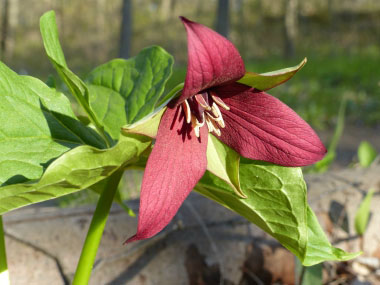
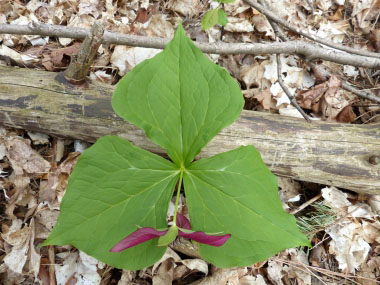
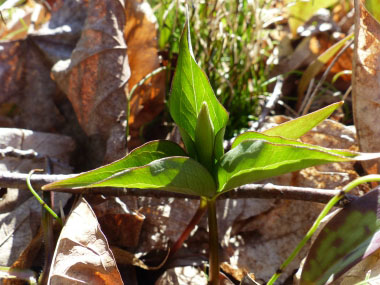
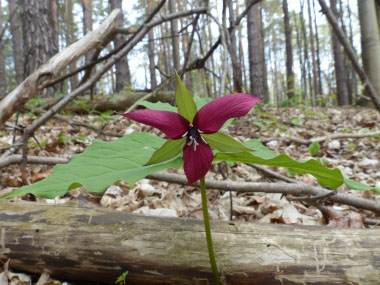
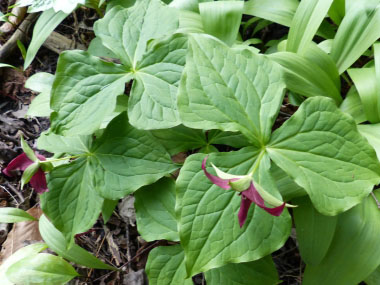
To support our efforts please browse our store (books with health benefits, etc.).
The red trillium has a number of common names which are reflective of many of its distinctive ecological, anatomical, and chemical properties. Also known as Wakerobin, Stinking Benjamin or Beth Root, this plant has long been used medicinally as well as for edible uses. The root is an antiseptic, astringent, expectorant, tonic, and a uterine tonic. This is a plant when used medicinally, cautions must be taken. It can cause nausea in high doses and promote labour and menstruation. It should never be used during pregnancy. Red trillium is in the Trilliaceae family. Be sure to familiarize yourself with local laws before foraging because in some areas this is a protected plant.
Distinguishing Features
The red trillium is easy to identify as it has one flower with three petals. The flower occurs on the rising stalk above the leaves. The flower has an unpleasant odour.
Flowers
Flowers are typically deep red (but may vary from pink to a lavender red) and sit atop a 2 to 8 cm tall stalk. Colour change in the petals is an indication that pollination has occurred. The three, lancelet-shaped flower petals are 3 to 7 cm long and up to 3 cm wide. Blooms on an individual plant may, under ideal conditions, persist for a month. Red trillium blooms in the early to mid spring depending on weather and local conditions. Plants need to reach an age of 15 years before they bloom. Plants can live for up to 30 years.
 Fields
of Nutrition has medicinal benefits and vitamin/mineral content of Red Trillium.
Fields
of Nutrition has medicinal benefits and vitamin/mineral content of Red Trillium.
Leaves
Leaves are whorled; there are three or more leaves per node along the stem. The leaf blade shape is ovate (widest below the middle and broadly tapering at both ends). Red trillium leaf blades are rhombic (roughly diamond-shaped). Its leaves can be up to 17.5 cm long (7”), and are net-veined, rather than parallel veined which are more typical of the lily family.
Height
20 to 50 cm (7 to 19”).
Habitat
Red trillium prefers cool, rich, moist, neutral to acidic soils of upland deciduous forests, mixed deciduous-coniferous forests, coniferous swamp borders at elevations of 200 to 700 metres (650 to 3,000').
Edible Parts
Leaves can be eaten raw or cooked. Used in spring, the young unfolding leaves are an excellent addition to the salad bowl, having a taste that is somewhat reminiscent to sunflower seeds. Leaves can also be cooked as a potherb. Best to consume small quantities only.
Other Name
Beth Root.
Similar Plants
Winter Survival Food Handbook

PDF Plant Magazines
Types of Wild Food
Geographic Zones Seasons
Disclaimer
EdibleWildFood.com is informational in nature. While we strive to be 100% accurate, it is solely up to the reader to ensure proper plant identification. Some wild plants are poisonous or can have serious adverse health effects.
We are not health professionals, medical doctors, nor are we nutritionists. It is up to the reader to verify nutritional information and health benefits with qualified professionals for all edible plants listed in this web site. Please click here for more information.
Why Edible Wild Food?
- Food costs are rising
- Free, wild food is readily abundant
- Wild food adds nutrition to your diet
- Wild food can help treat various medical conditions





